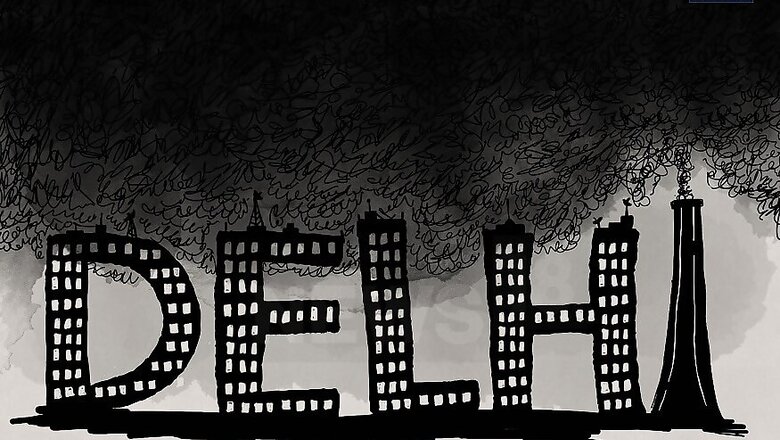
views
New Delhi: The day after Diwali, Delhi's air quality remained "very poor" while improving significantly over the previous year. But that, experts said, wasn't really a reason to cheer, with weather conditions greatly aiding the air quality, while systemic issues remain.
As per the National Air Quality Index, which the Central Pollution Control Board (CPCB) maintains, the worst air quality index (AQI) was at 11am on October 28 at 362. The day after, things worsened with the air quality hitting severe levels in Ghaziabad, Greater Noida, Panipat and Noida, while Delhi was on the cusp with an AQI of 400 (401-500 is ‘severe’ level) and Ghaziabad with an AQI of 446 was veering dangerously towards the emergency or ‘very severe’ levels.
But what does this mean for Delhi's air quality in the coming months?
The Delhi government and the Union government have maintained that the improvement in Delhi's air quality is due to their respective efforts. With the capital heading towards elections, the issue of Delhi's air quality has taken a political turn, with both the BJP and AAP accusing each other of concocting lies.
News18 breaks down the issues at hand, the extent to which efforts made by different agencies have taken off, and the key areas were enforcement needs to continue.
The Weather
The System of Air Quality and Weather Forecasting and Research (SAFAR), which is maintained by the Ministry of Earth Science and the Indian Institute of Tropical Meteorology, predicted that Delhi's air quality was likely to remain the cleanest in the past three years due to faster wind speeds that will aid in the dispersal of pollutants.
The Centre for Science and Environment, in an analysis on Tuesday, noted that the weekly trends of PM 2.5 levels — minute pollutants tinier than the breadth of a hair which embeds itself into the human body and causes a host of health issues — was "much cleaner before Diwali compared to that in 2018”.
While this points to the role played by fire crackers, it also serves to illuminate the extent to which weather plays a role in air pollution. It also serves as a warning for the upcoming months, experts said.
"This year, only Ghaziabad has experienced the season’s first 24-hour average severe pollution on Diwali day. However, there is early indication that air quality in the post-Diwali days could deteriorate to ‘severe’ category. Moreover, the onset of ‘poor’ and ‘very poor’ days has been delayed this winter. These have started to occur only after October 10. But during 2018, there were more such days, largely starting as early as September 26. Nearly all cities and towns had experienced severe pollution days even before Diwali (October 30, almost a week before Diwali)," an expert said.
An official of the CPCB told News18, "The issue that we are facing right now is that wind movement is minimal. So we have the post-Diwali pollution. On Diwali day itself, it was windier than last year and there was dispersal of pollutants. But the next day, when firecrackers were also exploded, saw little movement of the wind. So that pollution continues to be in the air."
Government Action and Gaps
There are two broad strategies for the control of air pollution. One is the Graded Response Action Plan (GRAP), a set of stratified actions that are taken once the pollution levels reach a specified limit.
An official of the Delhi Pollution Control Committee (DPCC), the watchdog for Delhi’s air pollution, effectively described it as an “emergency” measure. “Ideally, we should be in a situation that we don’t have to resort to this. But we are yet to see a winter where that is the case,” said the official.
The other, larger plan, is the Comprehensive Action Plan for Air Pollution Control in Delhi and NCR. These include measures that directly tackle the source of air pollution. For instance, it asks that the Delhi government ensure that “measures are taken to mitigate dust pollution from construction”.
But the DPCC official added, “Ideally, control measures for fugitive emissions from handling of materials be taken care of through water sprinkling or curtain barriers. But this doesn’t always happen in as robust a fashion as is necessary.”
The delayed data released by National Crime Records Bureau (NCRB), for the first time, didn’t differentiate between cases lodged under the Air Act and Water Act, instead clubbing them. But its results were telling.
In 2017, it found, no cases for air or water pollutions were registered in Delhi, while Rajasthan topped the list with 16 cases of the total 36 cases lodged in India. The performance, which an official of the CPCB described as "dismal", mirrors 2016, when 25 cases under Air Act and 11 under Water Act were lodged.
Enforcement and Political Will
A key issue, experts and officials admitted, was in the lack of political will in taking decisions which would be unpopular. A telling case in point is the resistance that the Supreme Court-mandated Environment and Pollution Control Authority (EPCA) faced when it wanted to extend the ban on diesel generator sets to other NCR cities — Noida, Gurgaon and Faridabad.
However, the state governments have been unwilling and pointed to the dependence on DG sets in a number of apartment complexes in these cities. This was the same issue that the Delhi government faced last year.
By November 2018, EPCA had received four 'formal' request and several informal ones. These included a request from the tourism ministry, one from the BCCI to request to fire up floodlights at the Feroz Shah Kotla stadium, the union ministry of food processing was granted permission to use them for the three-day-World Food India 2017 among others.
As per a 2015 study by IIT Kanpur, while diesel gensets alone caused 2% of the pollution, industrial and domestic sources, that often use diesel engines to power their activities, collectively contributed to 23% of the pollution, more than that caused by vehicles at 20%.
If all diesel generator sets, which have been allowed to operate in NCR towns due to “logistical reasons”, run for just two hours, then a total of 1,020 kilogram or a tonne of particulate matter will be generated, found an analysis by public policy consultancy Chase-India.
It also found the installed capacity of DG gen sets was 25.53 lakh KVA in NCR cities - Gurgaon (20.91 lakh KVA), Faridabad (92,601 KVA), (3.67 lakh KVA), Ghaziabad (62,080 KVA).
“This year, the measures that we have taken to combat air pollution have yielded some results. But we need to be vigilant and the focus has to be on enforcement,” said Anumita Roy Chowdhury, executive director at CSE.


















Comments
0 comment